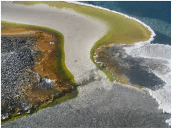|
Harsh Environmental Sensing |

|
Home | Contact Us | Research | Publications | People |
|
(Left) Hot springs in Yellow Stone National Park, (middle) Measured down flow region, (right) Conductivity map.
Hydrothermal ecosystems on continents and at the seafloor are locations of fluid mixing, dynamic cooling, rampant microbial activity, and enormous potential for mineral dissolution and precipitation. Water/rock/organic/microbe interactions occur on multiple scales in hydrothermal ecosystems, but most of the existing information comes from bulk sampling of fluids, sediments and gases. What is evident, even from the crude scale of bulk sampling, is that changes in microbial communities, isotopic measurements, and geochemical compositions are dramatic. In many cases, the sizes of water, sediment, or soil samples needed for laboratory analysis are larger than the scale at which changes occur. Sub-sampling can overcome this problem somewhat, but introduction of multidimensional sensor networks scaled to biogeochemical systems offers the promise of capturing dynamic behavior in situ, in real time, and at low cost. The need for sensor networks is great in aquatic systems in which composition and temperature respond dynamically to mixing, evaporation, microbial activity, atmospheric exchange, and water-mineral reactions. A very specific example of these hydrothermal ecosystems is hot springs. Hot spring ecosystems are some of the harshest inhabited environments on Earth. Hot springs occur when meteoric water is circulated through high-temperature rock; typically, hot rock surrounds magma chambers associated with volcanic activity or occurs in tectonically active regions. The water is delivered back to the surface at very high temperatures (∼100 °C). Large amounts of emerging water can form source pools. Water that rises above the rim of the source pool can spill out and form an outflow channel that carries water away from the source. These outflow channels host a diverse array of micro-organisms, from chemosynthetic microbes inthe hottest zones nearest the source to photosynthetic bacteria and eukarya in lower temperature regions farther away from the source. Studying this unique environment on Earth can provide scientists deep understanding on not only biogeochemistry, but also Astrobiology. Astrobiology is the research of the origin and evolution of life form in the universe. Astrobiologists study analog hydrothermal environments (e.g. hot springs) on Earth to understand possible life existence on certain planets, which demands high performance sensory system. However, these environments present high liquid temperatures (near boiling) and a wide range of pH values (~2-12), which limit the in-situ data collection using existing available commercial-off-the-shelf technology. To this end, we have developed a field-ready portable sensing system to study a specific hydrothermal system, hotsprings (e.g., in Yellowstone, US and Tengchong, China). Our study is taking two routes. The first one is to develop novel integrated devices for environmental sensing. My group uses acoustic resonators with ZnO as the sensing layer, validating various sensing functions, such as Ozone, UV, IR, ionizing radiation, pH and so on. Meanwhile, to accurately sense the flow speed in the liquid near the boiling point, we have invented cool-film flow sensors that use a thermoelectric cooler to build a cooled thermal boundary in the flow instead of a conventional hot-film anemometer. The second route is to build measurement instruments with micro sensor arrays for in-situ geology measurements. With our sensing system, the geologists obtained the first ever temperature and conductivity mapping for the hot spring with spatial resolution of centimeter (cm) level. In the future these two routes will be converged to integrate comprehensive functions and novel sensors into this field applicable sensing system.
· J. Oiler, E. Shock, H. Hartnett, AJ. Dombard, and H. Yu, "Harsh Environment Sensor Array-Enabled Hot Spring Mapping," Sensors Journal, IEEE , vol.14, no.10, pp.3418,3425, Oct. 2014 doi: 10.1109/JSEN.2014.2334674 (pdf) · Z. Wang, X. Qiu, J. Shi and H. Yu, “Room Temperature Ozone Detection using ZnO based Film Bulk Acoustic Resonator (FBAR)” Journal of the Electrochemical, 2012: Volume: 159 Issue: 1 Pages: J13-J16 DOI: 10.1149/2.054201jes (pdf) · X. Qiu, R. Tang, S.Chen, H. Zhang, W. Pang, and H. Yu, “pH Measurements with ZnO based Surface Acoustic Wave Resonator”, Electrochemistry Communications, 2011: Volume: 13 Issue: 5 Pages: 488-490 (pdf) · Z. Wang, X. Qiu, S. Chen, W. Pang, H. Zhang, J. Shi, and H. Yu, “ZnO based Film Bulk Acoustic Resonator as Infrared Sensor”, Thin Solid Films, 2011: Volume: 519 Issue: 18, Pages: 6144-6147 (pdf) · X. Qiu, J. Oiler, J. Zhu, Z. Wang, R. Tang, C. Yu and H. Yu, “Film Bulk Acoustic-Wave Resonator based Relative Humidity Sensor using ZnO Films”, Electrochemical and Solid-State Letters, 13, 2010, J65-J67. (pdf) · X. Qiu, J. Zhu, J. Oiler, C. Yu, Z. Wang, and H. Yu, “Film Bulk Acoustic-wave Resonator Based Ultraviolet Sensor”, Applied Physics Letter, 2009: vol. 94, 16 DOI: 10.1063/1.3122342 (PDF) |


